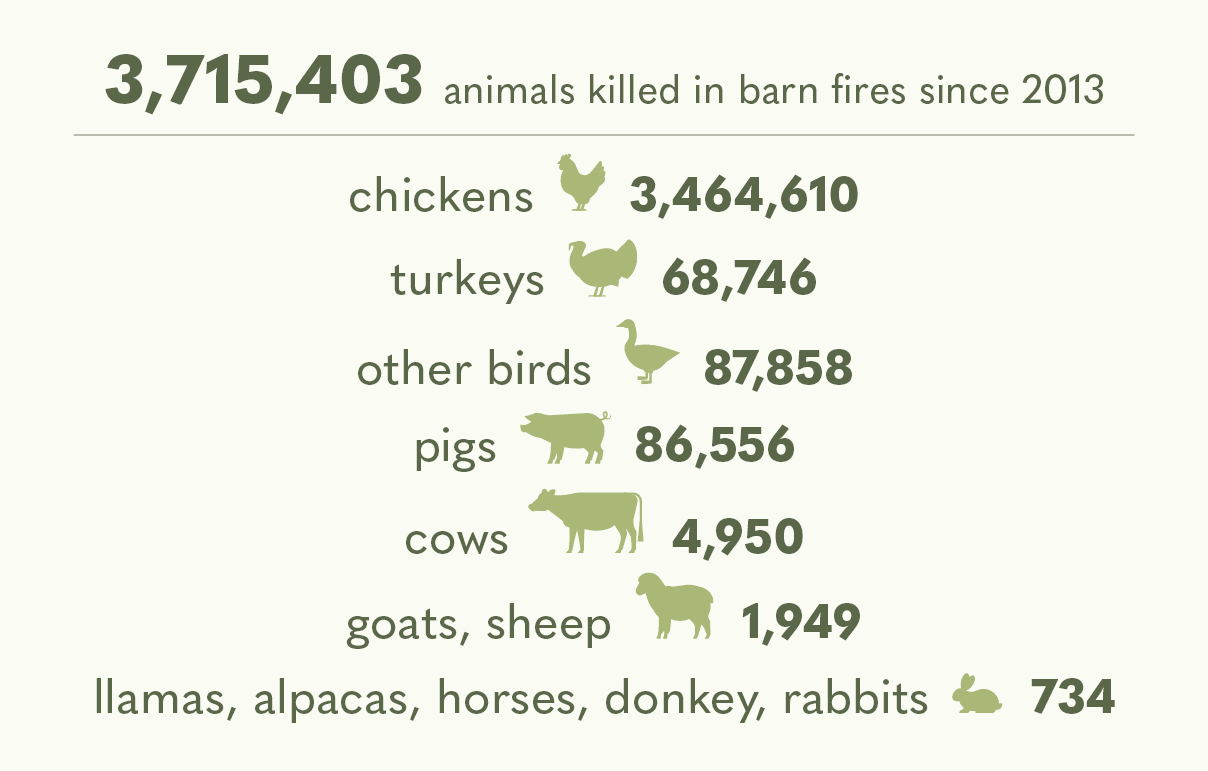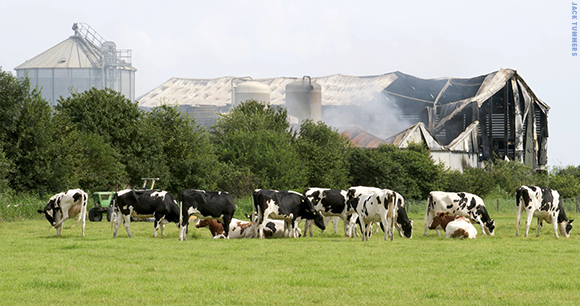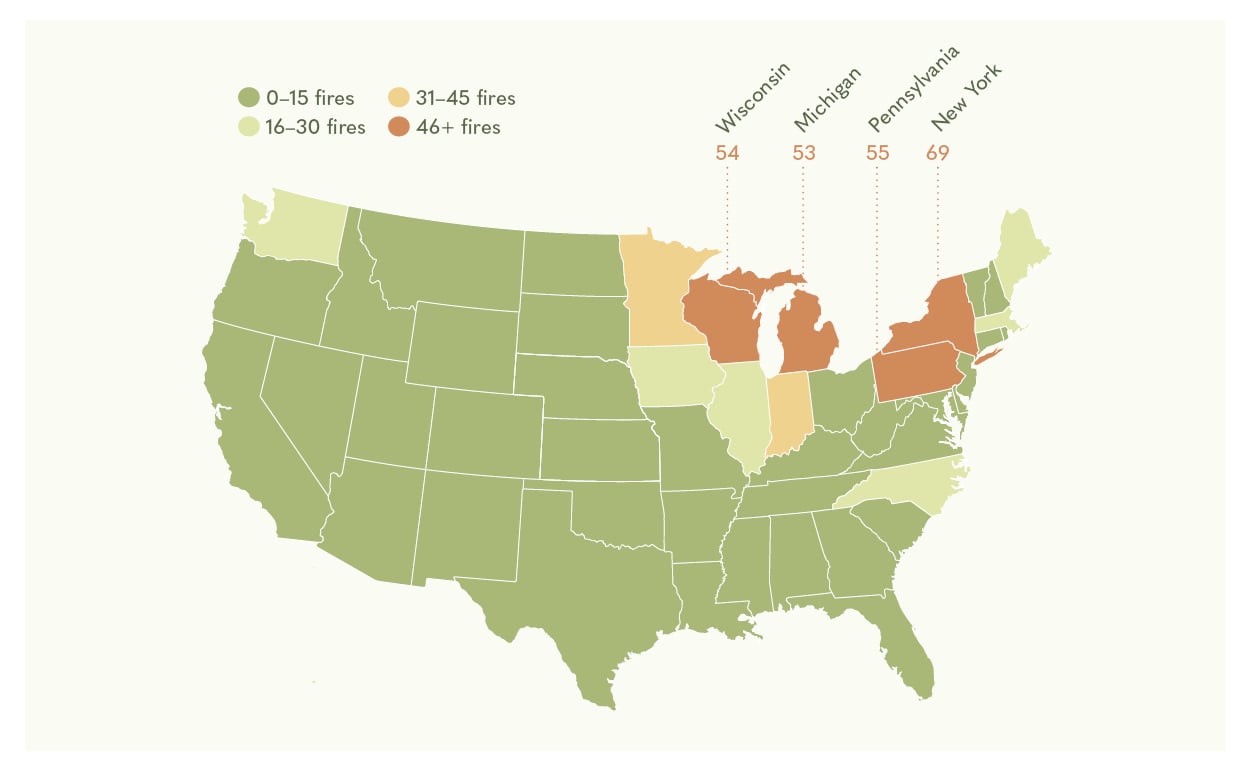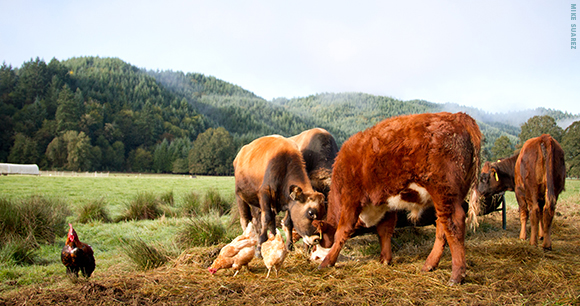In January 2020, an estimated 10,000 chickens perished in a fire just west of Winston-Salem, North Carolina. The blaze spread quickly after reportedly activating exhaust fans in a poultry house managed by Mountaire Farms. Delaware-based Mountaire, the sixth-largest poultry company in the United States, pumps out tens of millions of pounds of ready-to-eat chicken each week.
Less than 24 hours after the fire in North Carolina, a poultry house in Fulks Run, Virginia, burned to the ground, killing all 24,000 chickens trapped inside. The county’s deputy fire marshal, Joe Mullens, told one media outlet that the structure, which was built in 1978, was exempt from fire codes; he merely encouraged farmers to practice “good housekeeping.”
When thousands of animals burn to death, it should sound an alarm. Yet, because farm animals are viewed as expendable commodities — not beloved pets — their deaths receive little more than a passing interest by factory farm operators who produce animals by the billions and are insured against such losses. Proven fire deterrents are often completely ignored.
Since 2013, my organization, the Animal Welfare Institute (AWI), has compiled media reports to track more than 650 barn fires around the country that have killed more than four million farm animals to date.
In 2019, Michigan reported the most animal deaths from fires (more than 253,000 deaths in 17 fires). But shortly after ringing in the new year, the state had already eclipsed that death toll. On January 3, 2020, a devastating fire tore through an egg farm in Otsego operated by Konos Inc., a Vande Bunte Eggs distributor, killing 300,000 egg-laying hens. Rob Knecht, vice president of operations at Konos, was quick to point out that the staggering loss of life wouldn’t affect the company’s production schedule. It also wouldn’t lead to any meaningful fire prevention improvements.

North Carolina ranked second in AWI’s 2019 barn fire analysis (more than 42,500 deaths in five fires); Pennsylvania was a close third (more than 42,000 deaths in 14 fires). In all, nearly half a million farm animals perished in potentially preventable barn fires in 2019 — more than triple the number in 2018.
Though these statistics are grim, they don’t even represent the full scale of the tragedy. Municipalities aren’t generally required to report barn fires, and some companies decline to release the information to the public. For example, Cal-Maine Foods, the country’s largest producer and marketer of shell eggs, failed to disclose the number of hens killed in a Kansas fire in November 2019 that destroyed an entire barn, which probably housed thousands of birds.
The official cause of most fires is unreported or characterized as “unknown.” AWI research, however, shows that electrical malfunctions or improperly placed or faulty heating devices are often the culprit.
Two major patterns have emerged from our analysis: Birds — in particular, egg-laying hens — account for the vast majority of barn fire victims, given that extreme confinement is the norm for the commercial egg industry. Additionally, most fires occur during colder weather, possibly due to an increased reliance on electrical heating devices. In fact, a disproportionate number of barn fire deaths occur in Northeastern and Midwestern states with lower levels of animal agriculture production.

Cows, pigs, chickens, ducks and turkeys die in large numbers in barn fires for the same reason they do in hurricanes, floods, blizzards, and other natural disasters: There is little legal mandate to ensure their safety. There are no federal laws in the United States designed to protect farm animals from barn fires, and farm animals generally are not protected by any municipal codes or state laws. In reality, they receive considerably less protection than other species of confined animals, such as those living in laboratories or zoos.
Various codes exist for the construction and maintenance of office buildings to keep the workers inside safe, yet such protections are not afforded to farm animals in barns. When a fire does erupt, it is often not detected or suppressed until it rages out of control, consuming an entire barn and all the terrified animals inside. Some farm animals die almost immediately while others have to be euthanized later due to severe burns and smoke inhalation.
A number of fire suppression and prevention methods are available to producers. These include enlisting the local fire department to perform annual hazard inspections of facilities, installing smoke and heat detection systems, adding sprinkler systems, drafting emergency plans under the guidance of a fire protection engineer, and properly training employees in these procedures. In areas with limited water supply, producers can build on-site water storage containers.

AWI is urging poultry trade associations, including the National Chicken Council and United Egg Producers, to revise their animal care guidelines to ensure that all producers comply with the National Fire Protection Association’s “Fire and Life Safety in Animal Housing Facilities Code.”
The animal agriculture industry has been opposed to making any changes in their production practices to prevent or suppress fires. The industry flexed its considerable muscle in 2012 to block the National Fire Protection Association’s proposal of requiring sprinklers and smoke detectors, arguing that the systems are impractical and costly. Fire hazard inspections were criticized as being a risk to animal health and biosecurity. In discussions with AWI, the industry has argued that no additional action on barn fires is needed because the percentage of farm animals who lose their lives in fires is extremely low compared to the number pumped out every year.
Failing to act, however, has grave repercussions. As larger barns are constructed to meet consumer demand, we can expect an increasing number of birds succumbing to barn fires. Moreover, barn fires have injured and even killed operators and employees and caused millions of dollars in damage to industrial farms.
Poultry companies depend on these animals for their livelihood. At the very least, they should be obligated to take basic precautions to spare them an excruciating death by fire.
What Consumers Can Do
The average meat-eater will consume a total of 2,500 pigs, cows, chickens, turkeys and sheep in their lifetime. To give all farm animals a life worth living, Americans need to eat fewer products derived from them — that means less meat, dairy and eggs.
Ensure your food choices alleviate animal suffering rather than perpetuate cruelty. If you consume animal products, buy from family farms where animals are not confined to cages or crates (making them sitting targets for barn fires), and where they are able to roam freely and behave naturally.
When shopping for meat, dairy and eggs, look for labels indicating the product is third-party certified for animal welfare. AWI publishes a handy guide for consumers that divides claims about how farm animals are raised into “best choices” — such as Certified Animal Welfare Approved by AGW (A Greener World) and Global Animal Partnership’s Steps 4 and 5 — “next best choices,” “potentially good choices,” and “beware of these labels.”

In late March 2020, AWI sent a letter to John Starkey, president of the U.S. Poultry & Egg Association, urging the world’s largest poultry organization to immediately implement barn fire prevention strategies. AWI included a petition signed by 10,000 consumers nationwide calling on the industry group to act. This is in addition to the 5,000 emailed letters that were recently sent by concerned citizens to the organization. To join this effort, click here.
Change is urgently needed. We hope that before millions more animals are needlessly killed, the industry will make preventing barn fires a priority and work with all stakeholders to put forth meaningful solutions.
This article was produced by Earth | Food | Life, a project of the Independent Media Institute.
Our most important fundraising appeal of the year
December is the most critical time of year for Truthout, because our nonprofit news is funded almost entirely by individual donations from readers like you. So before you navigate away, we ask that you take just a second to support Truthout with a tax-deductible donation.
This year is a little different. We are up against a far-reaching, wide-scale attack on press freedom coming from the Trump administration. 2025 was a year of frightening censorship, news industry corporate consolidation, and worsening financial conditions for progressive nonprofits across the board.
We can only resist Trump’s agenda by cultivating a strong base of support. The right-wing mediasphere is funded comfortably by billionaire owners and venture capitalist philanthropists. At Truthout, we have you.
We’ve set an ambitious target for our year-end campaign — a goal of $250,000 to keep up our fight against authoritarianism in 2026. Please take a meaningful action in this fight: make a one-time or monthly donation to Truthout before December 31. If you have the means, please dig deep.
